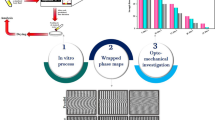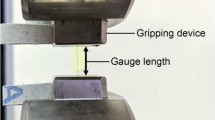Abstract
In this study, as a first step toward the development of novel candidate for absorbable suture materials based on poly(glycolide-co-ɛ-caprolactone), we synthesized a poly(glycolide-co-ɛ-caprolactone-co-l-lactide) block copolymer with ABA block structure via a two-step polymerization process and prepared the final PGCLA suture using a pilot-scale melt spinning machine. Then, to understand the mechanism on the early degradation stage of the PGCLA suture, we systematically investigated the mechanical, morphological properties and microstructural changes of the PGCLA suture through in vitro degradation. As a result, it was observed that, during the in vitro degradation process, the mechanical properties of PGCLA sutures exhibited an overall linear decrease and retained only 32% of its initial strength at 2 weeks of degradation. In addition, it was confirmed that, from FE-SEM analysis, internal degradation and structural changes, including longitudinal cracks on the suture surface, were noticeably appeared at 2 weeks of degradation. Interestingly, the results obtained from 1H-NMR and WAXS analyses exhibited clearly that PGCLA sutures undergo simultaneous degradation of glycolide units and l-lactide units present in the amorphous region during in vitro degradation. Therefore, based on these findings, we concluded that in the early stage of in vitro degradation of PGCLA suture, simultaneous degradation of glycolide units and l-lactide units in the amorphous region occurs, leading to chemical and structural changes such as erosion and cracking of the suture, as well as a decrease in its mechanical properties.











Similar content being viewed by others
Data Availability
The datasets used and/or analyzed during the current study available from the corresponding author on reasonable request.
References
C.K.S. Pillai, C.P. Sharma, J. Biomater. Appl. 25, 291 (2010)
J.P. Singhal, H. Singh, A.R. Ray, Polym. Rev. 28, 475 (1988)
K. Syamala Devi, P. Vasudevan, J. Macromol. Sci. C 25, 315 (1985)
A.C. Vieira, J.C. Vieira, R.M. Guedes, A.T. Marques, Mater. Sci. Forum 636–637, 825 (2010)
A. Pandey, G.C. Pandey, P.B. Aswath, J. Mech. Behav. Biomed. Mater. 1, 227 (2008)
H. Bramfeldt, P. Sarazin, P. Vermette, J. Biomed. Mater. Res. A 83, 503 (2007)
K. Tomihata, M. Suzuki, N. Tomita, Bio-Med. Mater. Eng. 15, 381 (2005)
E.K. Odermatt, L. Funk, R. Bargon, D.P. Martin, S. Rizk, S.F. Williams, Int. J. Polym. Sci. 2012, 216137 (2012)
Y. Baimark, R. Molloy, N. Molloy, J. Siripitayananon, W. Punyodom, M. Sriyai, J. Mater. Sci. Mater. Med. 16, 699 (2005)
D.K. Gilding, A.M. Reed, Polymer 20, 1459 (1979)
R.S. Bezwada, D.D. Jamiolkowski, I.Y. Lee, V. Agarwal, J. Persivale, S. Trenka-Benthin, M. Erneta, J. Suryadevara, A. Yang, S. Liu, Biomaterials 16, 1141 (1995)
Y.J. Low, M.I. Kittur, A. Andriyana, B.C. Ang, N.I.Z. Abidin, J. Mech. Behav. Biomed. Mater. 140, 105723 (2023)
R.S. Bezwada, D.D. Jamiolkowski, and S.W. Shalaby, US Pantent. 5,133,739 (1992)
D.D. Jamiolkowski and S.W. Shalaby, US Patent. 4,700,704 (1987)
M.H. Jee, J.H. Park, S.Y. Choi, D.H. Baik, Fiber. Polym. 63, 280 (2022)
K. Tomihata, M. Suzuki, Y. Ikada, J. Biomed. Mater. Res. 58, 511 (2001)
C.P. Ooi, R.E. Cameron, J. Biomed. Mater. Res. 63, 280 (2002)
Author information
Authors and Affiliations
Corresponding authors
Ethics declarations
Conflict of interest
The authors declare that there is no conflict of interests regarding the publication of this article.
Rights and permissions
Springer Nature or its licensor (e.g. a society or other partner) holds exclusive rights to this article under a publishing agreement with the author(s) or other rightsholder(s); author self-archiving of the accepted manuscript version of this article is solely governed by the terms of such publishing agreement and applicable law.
About this article
Cite this article
Jee, M.H., Choi, S.Y., Kang, C.S. et al. Mechanical Properties, Morphological Characteristics and Microstructural Changes of Poly(glycolide-co-ε-caprolactone-co-l-lactide) Suture during In Vitro Degradation. Fibers Polym 24, 3037–3045 (2023). https://doi.org/10.1007/s12221-023-00284-8
Received:
Revised:
Accepted:
Published:
Issue Date:
DOI: https://doi.org/10.1007/s12221-023-00284-8




